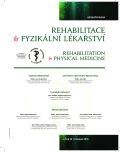CI therapy – a Chance for Chronic Patients after Brain Damage
Authors:
K. Laská; R. Holaňová
Authors‘ workplace:
Sanatoria Klimkovice, prim. MUDr. T. Bauko
Published in:
Rehabil. fyz. Lék., 23, 2016, No. 4, pp. 209-212.
Category:
Original Papers
Overview
Constraint Induced Movement Therapy (CI therapy) represents a concept for the therapy of patients after brain damage in the chronic stage of the disease. It is presently an intensive therapeutic rehabilitation program of the Klimkovice Sanatoriums, which are the only certified workplaces for this kind of therapy n the Czech Republic. The concept was adopted from abroad with first very good clinical results at our workplace. The structure is relatively fixed and the therapeutic approach is influenced by psychological elements. The theory of this therapy states that it is necessary to overcome the accustomed lack of using the extremity (or in case of the lower extremity its wrong use). The therapy includes a part devoted to special interventions, sc. Shaping procedures, part of common daily activities in Task Practice duties and Transfer Package. The composition of a Behavioral treaty is the indispensable part as well as putting a special glove on the healthy extremity aimed at limiting active locomotion for the period of three weeks in case of CI therapy of upper extremity..
Keywords:
CIMT, CI therapy, Shaping tasks, Task Practice tasks
Sources
1. DOIDGE, N. et al.: Váš mozek se dokáže změnit. 1. Brno. Computer press, 2011. 367 s.
2. FLEET, A., PAGE, S. J., MACKAY, L. YONS, M., BOE, S. G.: Modified Constraint-Induced Movement Therapy for upper extremity recovery post stroke: what is the evidence? Top Stroke Rehabil., 21, 2014, 4, s. 319-331.
3. CHEN, Y. P. et al.: Effectiveness of constraint-induced movement therapy on upper-extremity function in children with cerebrál palsy: a systematic rev and meta-analysis of randomized controlled trials. Clin. Rehabil., 2014, Aug 14. pii: 0269215514544982 [Epub ahead of print].
4. KONG, E. J., CHUN, K. A., NEONY, J. H., CHO, I. H.: Nucl. Med. Mol. Imaging., 47, 2013; 2, s. 119-124.
5. LINTERN, G. et al.: Adaptive training of perceptual motor skills: issues, results and future directions. Journal of Man-Machine Studies, 10, 1978, s. 521-551.
6. MORGAN, W. G.: The shaping game: A teaching technique. Nebav. Therapy, 1974, 5, s. 271-272.
7. MORRIS, D. et al.: Constraint-Induced Movement Therapy: a new family of techniques with broad application to physical rehabilitation – a clinical review. Journal of Rehabilitation Research Development, 36, 1999, s. 237-251.
8. MORRIS, D. et al.: The reliability of the Wolk Motor Function Test for assessing upper extremity motor function following stroke. Archives Phys. Med. Rehabil., 82, 2001, s. 750-755.
9. RAGAIE, A. L., HELOW, M. et al.: Efficacy of modified constraint induced movement therapy in acute stroke. Eur. J. Phys. Rehabil. Med., 2014, Jul 17. [Epub ahead of print].
10. ROSTAMI, H. R. et al. Feasibility of the modified constraint-induced movement therapy in patiens with median and ulnar nerve injuries: a single-subject A-B-A design. Clin. Rehab., 2014, Jul 9. pii: 0269215514542357. [Epub ahead of print]
11. TAUB, E. et al.: Technique to improve chronic motor deficit after stroke. Archives Physical Medicine Rehabilitation, 74, 1993, s. 347-354.
12. TAUB, E. et al.: An operant approach to overcoming learned nonuse after CNS damage in monkeys and man: the role of shaping. Journal Exp. Anal. Nebav., 61, 1994, s. 281-293.
13. TAUB, E.: Harnessing brain plasticity through behavioral techniques to produce new treatment in neurorehabilitation. American Psychology, 59, 2004, s. 692-704.
14. TAUB, E. et al.: The learned nonuse phenomenon: implications for rehabilitation. Eura Medicophys, 42, 2006, s. 241-255.
15. TAUB, E., USWATTE, G., MARK, V. W.: The functional significance of cortical reorganization and the paralel development of CI therapy. Front. Hum. Neurosci., 2014, Jun 27, 8:396. doi: 10.3389/fnhum.2014.00396. eCollection 2014.
16. TAUB, E. et al.: Constraint-Induced Movement Therapy combined with conventional neurorehabilitation techniques in chronic stroke patiens with plegic hands: a case series. Arch. Phys. Med. Rehabil., 94, 2013, 1, s. 86-94.
17. THRANE, G., FRIBORG, O., ANKE, A., INDREDAVIK, B.: A meta-analysis of constraint-induced movement therapy after stroke. J. Rehabil. Med,. 2014. Sep 2. doi: 10.2340/16501977-1859. [Epub ahead of print].
18. WAGNER, J. M., DOMERICK, A. W., SAHRMANN, S. A., LANG, C. E.: Upper extremity muscle activation during recovery of reaching in subjects with post-stroke hemiparesis. Clinical Neurophysiology, 118, 2007, s. 164-176.
Labels
Physiotherapist, university degree Rehabilitation Sports medicineArticle was published in
Rehabilitation & Physical Medicine

2016 Issue 4
Most read in this issue
- Congenital Synostosis of Vertebras C4 a C5
- The Relation between Stress, Psychoneurotic Symptoms and Traits, and Neck Pain
- Functional Independence Measure as an Indicator of Patient Disability - Evaluation of Practical Experiences
- CI therapy – a Chance for Chronic Patients after Brain Damage
